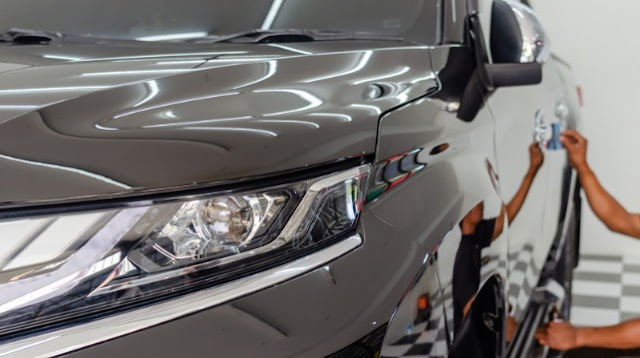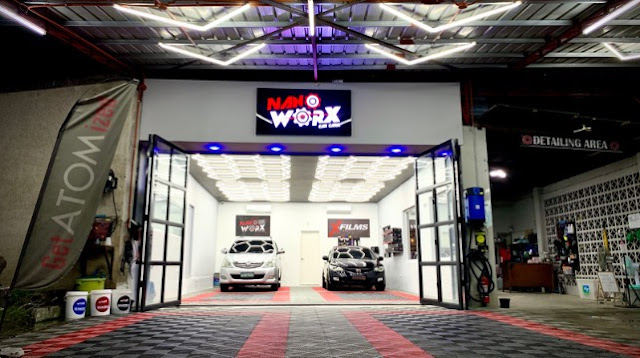Differences Between Ceramic and NanoCeramic Coating
Main Differences Between Ceramic Coating and NanoCeramic Coating
Ceramic Coating
Ceramic coating, also known as glass coating or quartz coating, is a liquid polymer-based protective coating that contains SiO2 (silicon dioxide) or TiO2 (titanium dioxide). When applied to a vehicle's paintwork, it chemically bonds with the surface, forming a protective layer that provides several benefits.Ceramic coatings are designed to offer exceptional durability, chemical resistance, UV protection, and hydrophobic properties. They can help protect the paint from environmental contaminants, UV rays, oxidation, and minor scratches.
NanoCeramic Coating
Nanoceramic coating is a type of ceramic coating that incorporates nanotechnology. It utilizes nanoparticles, tiny particles with dimensions typically less than 100 nanometers.The addition of nanoparticles enhances the coating's properties and performance. Nanoceramic coatings often provide more outstanding durability, hardness, and hydrophobicity than regular ceramic coatings.
The nanoparticles are believed to create a tighter and more uniform molecular structure on the surface, improving protection.
Which One is Better? Ceramic Coating or NanoCeramic Coating?
Determining which is better between ceramic and nanoceramic coating is subjective, as it depends on individual preferences and priorities.
Durability
Both ceramic coatings and nanoceramic coatings are known for their durability. However, some nanoceramic coatings claim to offer even greater hardness and longevity due to the incorporation of nanoparticles. If durability is a primary concern, consider nanoceramic coatings.Hydrophobic Properties
Ceramic coatings, including nano ceramic coatings, are designed to create a hydrophobic surface, meaning they repel water and help prevent dirt and contaminants from adhering to the surface.While both types can provide hydrophobic properties, nanoceramic coatings may offer enhanced water beading and sheeting due to their tighter molecular structure.
Scratch Resistance
Ceramic coatings, in general, provide a certain level of scratch resistance to the paintwork. However, the specific formulation and hardness can vary among different products.Some nanoceramic coatings claim to offer superior scratch resistance thanks to the inclusion of nanoparticles. However, it's essential to note that no coating is entirely scratch-proof.
UV Protection
Both ceramic and nanoceramic coatings can provide UV protection to some extent, helping to prevent the paint from fading or oxidizing due to sun exposure. The level of UV protection might vary between different products, so it's advisable to check the specific features and claims of the coating.Application and Cost
The application process for ceramic coatings and nanoceramic coatings is generally similar. However, nanoceramic coatings might require more meticulous and precise application due to the use of nanoparticles.As for cost, nano ceramic coatings are often marketed as premium products and may come with a higher price tag than regular ceramic coatings
How do You Distinguish if Your Car's Coating is Ceramic or Nano Ceramic?
While an inexperienced eye can't precisely distinguish the difference, here are some methods that may help:
Contact the Provider/Applicator
Reach out to the provider or applicator of the coating and inquire about its composition. Ask for accurate information regarding the type of coating used on your car.
Visual Inspection
Examine the coating's appearance and texture. Ceramic coatings typically have a glossy and glass-like finish, while nanoceramic coatings may exhibit similar characteristics but with enhanced clarity and smoothness. However, this visual examination alone still cannot definitively confirm the type of coating.Performance Characteristics
Evaluate the performance characteristics of the coating. Ceramic coatings, whether conventional or nanoceramic, provide high levels of hardness, chemical resistance, and durability.However, nanoceramic coatings often offer additional features such as enhanced hydrophobicity, self-cleaning properties, or increased scratch resistance. If the layer displays exceptional performance beyond typical for conventional ceramic coatings, it may indicate a nanoceramic formulation.
Professional Testing
Consult with a professional coating inspector or a materials testing laboratory. These experts have specialized tools and techniques to analyze the composition and structure of coatings.They can perform tests like Fourier-Transform Infrared Spectroscopy (FTIR) or Scanning Electron Microscopy (SEM) to identify the presence of nanoparticles and determine if it is a nanoceramic coating.
What are the Disadvantages of Nano Ceramic Compared to Ceramic Coatings?
Nanoceramic coatings and traditional ceramic coatings share similarities in terms of their composition and purpose. However, nanoceramic coatings offer advantages over conventional ceramic coatings while having a few potential disadvantages.
Here's a comparison of the disadvantages of nanoceramic coatings when compared to ceramic coatings:
Cost
Nanoceramic coatings are generally more expensive than traditional ceramic coatings. The advanced technology and improved performance of nanoceramic coatings contribute to their higher price point.If cost is a significant factor, a traditional ceramic coating might be a more affordable option.
Application Complexity
Nanoceramic coatings often require meticulous surface preparation and application techniques. The application process may involve multiple steps and higher expertise to achieve optimal results.On the other hand, traditional ceramic coatings can be slightly easier to apply, making them more accessible for DIY enthusiasts.
Skill and Time Requirements
The application of nanoceramic coatings can be more time-consuming and labor-intensive compared to traditional ceramic coatings. The additional steps involved in the application process, such as paint correction and multiple coating layers, can require more skill and effort.While still requiring proper preparation, traditional ceramic coatings may be less time-consuming to apply.
Performance Claims
Some nanoceramic coatings make bold claims about their performance characteristics, such as extreme scratch resistance or self-healing properties.While these claims can be somewhat valid, evaluating them is essential. You can get independent testing and research user experiences to confirm them.
Traditional ceramic coatings generally have well-established performance characteristics without exaggerated marketing claims.
Availability and Brand Variability
Nanoceramic coatings are a relatively newer technology, and the market may have more variability in terms of quality and performance among different brands. Researching and choosing a reputable brand with positive reviews and proof of customer satisfaction is essential.Traditional ceramic coatings, having been around for longer, may have a more comprehensive selection of established and trusted brands.
Limited Independent Testing
Due to the relatively recent introduction of nanoceramic coatings, there may be a need for more extensive independent testing or long-term durability data available.Having been in the market for longer, traditional ceramic coatings may have more established data and industry standards to rely on.
How do You Find a Reliable Nano Ceramic Coating Specialist Near Me?
Finding a reliable service provider nearby is crucial if you're considering getting a nanoceramic coating for your vehicle. Here are some valuable tips to help you find a trustworthy and competent nanoceramic coating professional in your local area.
Research and Gather Information
Start by conducting thorough research online. Look for local businesses that specialize in nanoceramic coatings. Read customer reviews, visit their websites, and check their social media presence. Look for indications of professionalism, positive customer experiences, and the use of high-quality products.Seek Recommendations
Ask friends, family members, or fellow car enthusiasts for recommendations. Personal experiences and word-of-mouth referrals can provide insights into the quality of work and customer satisfaction. If someone you trust had a positive experience with a particular nanoceramic coating professional, it's worth considering.Assess Their Expertise
Evaluate the expertise and experience of the service providers you are considering. Look for technicians who specialize in nanoceramic coatings and have a good track record in the industry.Check if they undergo regular training to stay updated with the latest coating techniques and technologies. A reputable professional will have the knowledge and skills to prepare the surface properly and apply the coating.
Visit the Facility
Visit the facility where the coating application takes place. A professional coating shop should be clean, organized, and equipped with the required tools and equipment.Pay attention to professionalism, attention to detail, and overall cleanliness. A well-maintained facility indicates the care and precision the technicians put into their work.
Inquire about Product Quality
Ask about the specific nanoceramic coating products they use. Reputable professionals typically work with high-quality coatings from trusted manufacturers.Inquire about the durability, performance characteristics, and warranty provided with the coatings. Quality products contribute to the longevity and effectiveness of the coating.
Request Portfolios and Testimonials
Request portfolios or before-and-after photos or videos of previous coating projects they have completed. It will give you a visual representation of their work and the expected results.Additionally, ask for testimonials or references from previous customers. A reliable professional will gladly provide evidence of their successful coating applications and positive customer experiences.
Discuss Pricing and Services
While pricing should not be the sole determining factor, it is essential to discuss the cost of the nanoceramic coating service. Ask about the different packages available, what is included in each package, and any additional services they offer.Consider the value provided with the price quoted. Remember that quality work and the use of superior products often come with a higher price tag.
Request a Warranty
A reputable nanoceramic coating professional will provide a warranty for their work. Inquire about the warranty terms and duration, and ensure you understand what is covered.A warranty assures the service provider's confidence in their work and demonstrates their commitment to customer satisfaction.
Looking for a Reliable NanoCeramic Coating Specialist in Tarlac?
If you live in Tarlac or anywhere in Central Luzon, Philippines, and are looking for the most reliable NanoCeramic Coating Specialist with a good track record, quality work, and excellent aftersales support near you, visit Nanoworx Car Care Services at 30 Perez Avenue San Sebastian Village Gate 3 Tarlac City.
You can also inquire through our Facebook Page or choose from any options on our Contact Page.









